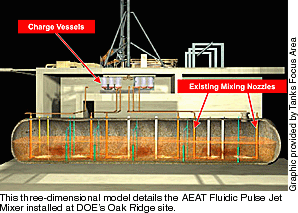
Russians pump it up at Oak
Ridge In a project sponsored by the Tanks Focus Area and Industry and University Programs, Russian and American engineers have developed and transferred to the United States a high-capacity, pulsating mixer pump for mobilizing slurry within a tank at the Oak Ridge National Laboratory’s Gunite and Associated Tanks cleanup project. The Pulsating Mixer Pump (PMP) proved it could mix and mobilize tank waste during a demonstration in a three-quarter–scale test tank at Pacific Northwest National Laboratory in the summer of 1997. The in-tank components of the PMP system are simple, rugged, and inexpensive—making it economically feasible to leave the pump in the tank after use, if desired. The more costly system components remain outside the tank and do not become contaminated under normal operating conditions. (OST/TMS ID 2401) The PMP system, containing an in-tank pump chamber, operates by drawing liquid waste into an upright cylindrical reservoir and then expelling it through jet nozzles, causing a mixing action within the waste tank. The PMP’s flow control system first applies a vacuum, which causes liquid waste to be drawn into the pump chamber via a foot-check valve. The control system then pressurizes the unit, causing the fluid to release through multiple jet valves at floor level. The result is scouring and mixing of the waste at the tank bottom. Using liquid waste to mobilize sludges and solids avoids the addition of fluids, minimizing the generation of additional waste. When sufficient mixing has occurred, the operator uses existing pumps to transfer the waste to storage tanks. As a hedge against expensive delays caused by down time, Oak Ridge has ordered three PMPs, a flow control and operator control system, and a containment and riser interface system. The relative low cost of the PMP units (approximately $25,000) as compared to the cost of one day of maintenance (potentially more than $100,000) makes the purchase a smart move. American Russian Environmental Services, Inc. (ARES), a joint U.S./Russian company, designed and fabricated the system with funding from the Tanks Focus Area and the National Energy Technology Laboratory’s Industry and University Programs. Cold testing is scheduled to begin soon, with deployment expected in June. OST funding for the deployment of the PMP is provided through an Accelerated Site Technology Deployment (ASTD) project. British firm is key player AEAT’s fluidic mixers and samplers have been deployed in tanks at Oak Ridge and Savannah River and are reducing the risks and costs of processing and sampling tank wastes. The Tanks Focus Area is funding development of AEAT’s fluidic mixers and samplers, while ASTD is helping to fund Oak Ridge deployments of fluidic mixers. The baseline methods for mixing tank material and taking representative samples are
expensive and In February and March 1999, Oak Ridge again used the Fluidic Pulse Jet Mixer in two
more tanks at Bethel Valley. The site installed 24-inch-diameter access ports at each end
of two Fluidic samplers are helping the Savannah River Site (SRS) safely obtain representative samples. Before tank waste is introduced into a treatment process, its chemical composition must be determined. Obtaining representative and reproducible samples is essential to control feed preparation. Surface samples obtained through manual dip sampling techniques are not representative of the entire tank contents. Dip sampling also requires more extensive work protection measures and increases the risk of environmental contamination. AEAT designs, manufactures, and installs its Fluidic Samplers (OST/TMS ID 2007) for obtaining samples from a range of tank depths while mixing, which ensures the homogeneity and therefore the representativeness of the sample. For more information on how AEAT’s Fluidic Sampler works, see Initiatives, June 1997 and the Innovative Technology Summary Report that’s available on OST’s Web site at http://ost.em.doe.gov/ifd/ost/pubs/tfa.htm. Two fluidic samplers have been installed at SRS. One can sample slurries at 30 wt %; it has been commissioned and has collected several representative samples. The other sampler collects slurries up to 20 wt %; it has completed functional testing and has been installed. AEAT is now looking forward to the installation of a third sampler at SRS by the end of July. A mobile tank waste retrieval system, another AEAT product based on the company’s patented PresCon® fluidics technology, has been configured to meet the needs of DOE sites with small waste tanks. Located throughout the DOE complex, these many small tanks must have their contents removed prior to tank decommissioning and closure. The tanks vary in shape and size and, although many have been sluiced in the last 15 years or so, they still contain between 10 and 6,300 gallons of radioactive waste. AEAT’s mobile tank waste retrieval system, designed to be low maintenance, is housed and transported within a shielded container. In an ASTD-funded campaign to empty and close 13 of Oak Ridge’s 20 small tanks, AEAT used its mobile tank waste retrieval system to mix, mobilize, extract, and transport waste from two small tanks to Tank W-23 at BVEST. The campaign, in which several other companies demonstrated their tank retrieval technologies, is scheduled to wrap up by the end of March (OST/TMS ID 2947). The United States and other countries around the globe are challenged to clean up radionuclide-contaminated soil and groundwater and dispose of nuclear waste. By bringing these countries and their resources together to tackle mutual environmental problems, the International Program is promoting an international science and technology community and reducing the costs and risks of DOE’s weapons complex cleanup. For more information about the International Program, see its Web site at http://www. |

 labor-intensive,
increase the risk of worker exposure to radiation, and often produce nonrepresentative
samples. At the Bethel Valley Evaporator Storage Tanks (BVEST) at Oak Ridge, AEAT’s Fluidic Pulse Jet Mixer
labor-intensive,
increase the risk of worker exposure to radiation, and often produce nonrepresentative
samples. At the Bethel Valley Evaporator Storage Tanks (BVEST) at Oak Ridge, AEAT’s Fluidic Pulse Jet Mixer